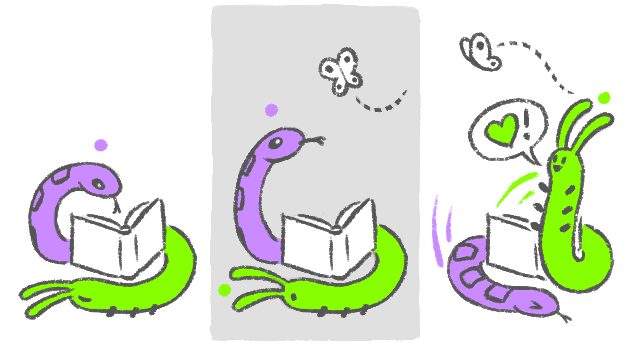Written by Snake, art by Worm
Usually, when we hear the word "trigger" used in regards to mental health, it carries a negative connotation. It means something external that can cause a negative emotional reaction, such as anxiety, psychosis, or flashbacks. However, DID/OSDD-1 systems can also have something called a positive trigger!

Just like negative triggers, positive triggers are an external force. The first difference is that positive triggers typically cause feelings of happiness, calm, safety, or even bring up good memories. They're also associated with specific system members, so they're a powerful tool for both grounding and learning to switch on purpose! A list of positive triggers is great to have handy in daily life, and can be even more important during a crisis.
Some common examples of positive triggers include:
- Hobbies or interests
- Favorite animals
- Favorite foods
- Locations
- Media, such as a song or movie
- Sensory input (smells, colors, sounds, etc.)
- Comforting objects, like a blanket or a stuffed toy
Just like negative triggers, positive triggers are personal. Anything can be a positive trigger, and no two systems will have the same ones!
Finding Your Positive Triggers
You may already have an idea of what your positive triggers are, but if not, how do you identify them? As positive triggers are often something that an individual system member feels a deep connection to, or feels strong positive emotions about, you can start by writing down a list of anything that you feel might fit that description. Over time, you can work through the list and weed through which are actually powerful enough to help you ground or switch, and which are just things you enjoy.
Whenever you notice yourself switch, try to keep an eye out for anything that might have caused it, or anything you feel yourself gravitating towards immediately after. Those may be positive triggers, too!
If you notice a positive trigger, it's a good idea to write it down for future reference! If you notice another system member's positive trigger, then you can write that down as well. However, depending on how much communication you have between you, you might ask for the other system member to confirm it for themself rather than stating it as a fact.
Using Positive Triggers
Positive triggers have a few practical applications. The first is that they're one of the most common ways to intentionally switch between system members! By lining up positive triggers around times you want (or need) to switch, you can draw specific system members to front without upsetting them, or yourself. Next week's article will be a more in depth look at how to do this.
They can also be a great way to ground yourself if you're having trouble staying at front, or need to keep negative emotions at bay. The nice thing about learning your positive triggers is that it's also a list of things that make you feel at ease, so they can be a great resource if you need something to cheer you up or calm you down. Just be careful that you give your negative emotions space to breathe too, and don't use your positive triggers to ignore them. It's also important to avoid using them to push away other system members who want to front, which can cause positive triggers to turn into negative triggers, and also erode trust between you.
Finally, it's a great way to build your identity, as a system and as an individual system member! In our experience, system members that are especially close to trauma can struggle with this, so recognizing their positive triggers is a great way for them to learn to be themselves outside of distressing memories and emotions.
A few additional safety notes: because positive triggers are so versatile, they can also be dangerous if they fall into the wrong hands. Keep yourselves safe by keeping your triggers between yourselves, and a few trusted people if necessary. If someone uses your positive triggers to drag someone to front against their will, be sure to let them know that it's not okay, and take any necessary steps to keep yourself safe in the future. Systems are not toys! While it's fine for someone to have closer relationships with some system members than others, treating the rest of the system like they're expendable or unwanted is insensitive, and can also be seriously damaging!
Next Saturday, we'll dive a little deeper into how to use positive triggers to switch on purpose. See you then!